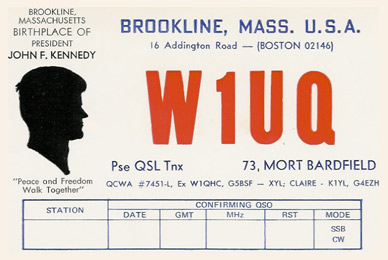
by: Morton "Mort" Bardfield, W1UQ / PJ7UQ
Brookline, Massachusetts
St. Maarten, Netherlands Antilles
Born: June 23, 1930
Silent Key: June 26, 2012

PREFACE:
As a Director of the Old Old Timers Club, I was asked to share my experiences starting as a young short-wave listener during World War II.
After the War, this pastime evolved into the hobby of Amateur Radio which eventually led me to many interesting experiences and opportunities. This story is lengthy but I'm sure some of it will be of interest to many of my ham friends.
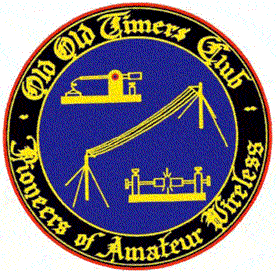
Back in the 1940's, the greater Boston area had a large share of major electronic research labs and radio companies. They included General Radio, Raytheon Electronics, Sub-Signal sonar labs, MIT-Draper Labs, Arthur D. Little research, Sylvania-Hygrade, Holtzer-Cabot Signaling, and Bell & Howell Electronics.
Old-timers will remember the name of Ted McElroy. His company in Littleton, Mass. manufactured telegraph keys, and he grew up in Boston where a neighbor and life-long friend was Bill Halligan, W9AC, who founded Hallicrafters Radio. Ted (who held the call W1JYN) could copy Morse code at about 75 w.p.m. -and he won many CW awards.
Some of the other “old-time” electronic companies in this area were the James Millen Mfg. Co., Ted Valpey Crystals, Harvey-Wells, National Radio, Sprague Capacitors, Tobe-Deutchman Capacitors, and Wm. Murdock Telegraph Keys. The big retailers were Lafayette Radio, DeMambro Radio, and the first Radio Shack store. Moreover, it was in downtown Boston where Alexander Graham Bell invented the telephone. During World War-II, the final development and use of Britain's radar was aided by the famous MIT “Radlab” in Cambridge, Mass.
Remembrances. When World War-II started, I was 11 years old and lived in the Roxbury-Dorchester area, a working-class section of Boston. There weren't many young hams or “able bodied” older kids around as most young men over the age of 17 or 18 were enlisting in the service. I kept busy with various after-school and weekend jobs, such as push-cart deliveries for a grocery store, working on delivery trucks and selling newspapers. The three Boston newspapers were the Globe, the Herald Traveler, and the Record American which sold for three cents!
Early in the war, I remember sending away penny postcards to the Office of War Information, Washington 25, D.C., requesting packages of free war posters. I liked the portraits by Norman Rockwell, and I understand that some of those free posters are now worth about five hundred dollars apiece.
In 1943 I received a Philco 3-band console radio for my thirteenth birthday and began listening to the short-wave band. There was no television back then, and our family had an AM console radio in the living room to listen to our favorite evening programs. These popular programs included the Lone Ranger, JackArmstrong, and The Shadow. Naturally, the new Philco radio with the short-wave band was located exclusively in the bedroom that I shared with my kid brother.
World War-II was raging on, and by hooking up an external wire toward the back yard, I was able to listen to the stations that broadcast in English each evening, such as the BBC and WLW in Cincinnati -and of course I couldn't avoid the short-wave signals of nearby station WRUL located on the Massachusetts coast. By tuning carefully I was also able to find weaker stations in Europe and South America.
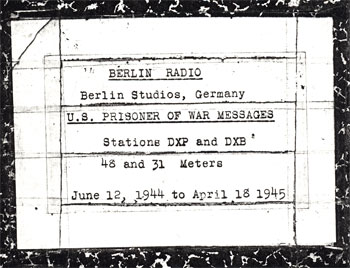
Cover of my first log book
Calling Back Home. I bought some newsstand radio magazines and before long my big electronic achievement at age 14 was a merit badge for radio in the Boy Scouts! I had also purchased a dime copy of White's Radio Log and found all the “enemy” propaganda frequencies of Berlin Radio on my all-wave console radio. I was also able to pick up an exciting evening radio program about American prisoners-of-war that was called “Calling Back Home”. The German announcers (both male and female, speaking perfect English) would give the American prisoner's name, rank, and address in the U.S., and then read a short message from the prisoner -who typically had been shot down over Germany.
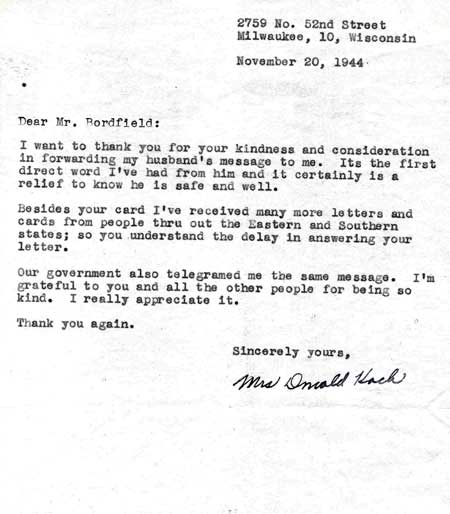
These American airmen had been officially listed for some time by the War Department as missing in action, but were now being reported by the Germans as prisoners of war. A typical message would say: “Hi Mom and Dad, I was shot down over Germany last month, and I'm in a POW camp where I am being treated well. I miss you all. Give my love to everyone, and I hope you can help put a stop to the war so I can return home”.
After the war, I read that there was an ironic contrast to Hitler's death camps. Hermann Goring -the head of the Luftwaffe, had been a World War-I “Flying Ace” and he kept a camaraderie for airmen which resulted in the “Stalag Luft” prison camps offering somewhat better treatment for the American airmen.
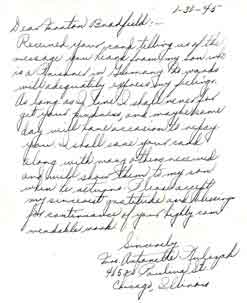
P.O.W. Letters. The signals were usually strong on the East coast. I kept a notebook of the messages that I was able to copy, as well as my notation of either the penny postcards or the 3-cent letters that I mailed to the prisoners' families. This hobby at age 14 with my short-wave receiver seemed like a normal thing to do for missing soldiers that had been fighting in the war. I still have some of the thank-you notes and letters from parents expressing their gratitude.
Many of the letters mentioned that they heard from other short-wave listeners also -but my continued mailing during the war seemed more rewarding than doing my school homework!
Cards like this were my real reward: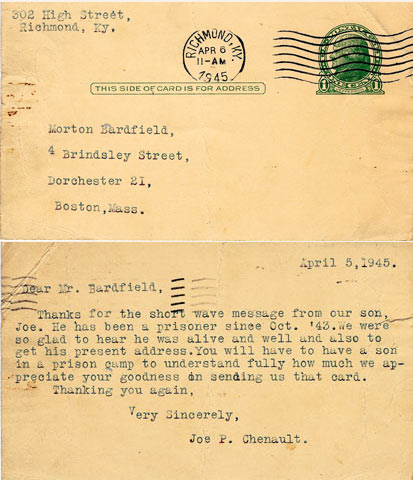
|
Stars in the Windows. One vision that stands out in my memory were the military service “plaques” that hung in the center of so many of the neighborhood windows. These small banners were embroidered with blue stars that indicated how many family members were in the military service. A gold star on the banner meant a serviceman had been killed. In walking down the main Washington Street in our multi-family area of Dorchester, I would see these banners in countless windows, many with gold stars.
Answered Prayers. The possibility of losing a child “hit home” almost 50 years later when I had grown children of my own. I could understand the feeling of those parents that knew their son's plane was shot down months earlier, and their child was officially “MIA”. These war-time parents were certainly prepared to hang a gold star in the window, but now had the joy of having their prayers answered.
Shallow-Water Blackout. In August of 1996 I also became another concerned parent, when my 19 year old son David (N1DDD/PJ7DB) was in a free-diving accident off the small Caribbean island of Saba.
After almost six minutes under water, David was retrieved unconscious from the sea bottom by a courageous scuba instructor named Clark Archibald of Palm Beach Gardens, Florida. Archibald made a rapid dive to the 120-ft. bottom to recover David, and then made a controlled emergency ascent back to the dive boat which was luckily equipped with an oxygen tank. Dave was in critical condition and was transferred by a private helicopter to St. Maarten where he was stabilized and intubated. Within an hour of the accident he was transported by a private Med-jet (owned by a local restaurateur) to the U.S. Naval Hospital in Roosevelt Roads, Puerto Rico, placed on the danger list, and then sent by a medic helicopter to the Centro Medico hospital center in San Juan.
After conferring with the doctors, (and notifying his college enrollment department) we sweated it out in Rio Piedras for fourteen long days. But then, Dave awoke from his coma and in spite of pneumonia setting in, he made a remarkable recovery that amazed the doctors. Two weeks later he was able to begin freshman classes at the University of Vermont. Some weeks later, doctors at Duke University asked Dave to come to their campus in Durham North Carolina to study his free-diving accident. Although David had spent more than 6 minutes underwater they couldn't detect any brain damage, and felt that his excellent physical condition before the accident was an important factor in his recovery.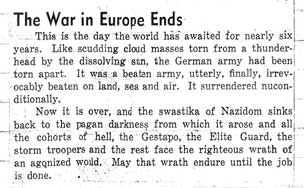
War-Time Radio. Back in the mid forties, I stayed up late (I still do!) while “DXing” the AM broadcast band in the early morning hours. Being on the East coast, I couldn't miss the stronger signals on the band, WWVA in Wheeling, West Virginia. This country station played lots of long-forgotten patriotic war songs. I recall “My Filipino Baby” (when the warship left Manila) and “A Soldier's Last Letter”. There was also a song entitled “There's A Gold Star In The Window Waving Somewhere”!
I seem to remember that in those days, almost every radio station played the National Anthem at sign-on and sign-off, and a constant patriotic standard seemed to be “God Bless America” -the most memorable rendition of which was sung by Kate Smith, and in those days, tears were never an embarassment.
Model Airplanes. In Junior High school during the early part of the war, I remember a class project in woodworking that was sponsored by the government. We built small solid-wood models of military airplanes. These scale models were about 8-inches long, which we painted black, and were all turned over to the military for recognition training. I was about 13 or 14 years old and would have given anything to keep one of those models!
Love It or Leave It. After December 7th 1941, most men couldn't wait to sign up for the service to avenge Pearl Harbor, and kids of 16 were lying about their age or forging their parents signature so they could enlist. When world war-II ended in 1946, I was still in high-school and although no one ever thought about it at the time, we were all playing a small part in what was later called “The Greatest Generation” -which to me meant a memorable five year war-time period of irreplaceable patriotism.
It was nice to see many of my cousins and uncles (and an aunt!) come back after the war as civilians, there wasn't a lot of publicity about the wounded. I recently read Senator Bob Dole's book about his own wounds which so aptly said "the real heroes of World War II are the men and women who never came back".
Radio Shack Company. During my last year of high school, I had an after-school job at the Radio Shack store in downtown Boston. It was a part-time “desk job” in a small corner on the second floor, where I enjoyed answering technical questions sent in by mail. I also handled the many requests to receive the Radio Shack catalog... we had nice hard-bound versions available, and I would reserve those versions for requests by servicemen.
The store manager was Lew Kornfeld, and he came by my desk one day to explain my part-time salary! He seemed a bit surprised when I said that the money wasn't that important -because I really enjoyed the work! Many years later, Kornfeld became President of Tandy-Radio Shack.
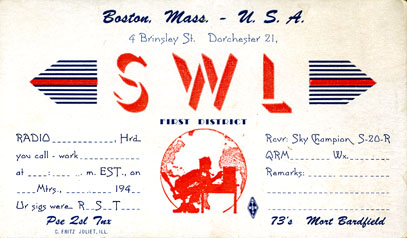
Radio Repairs. I had seen interesting pictures of signal corps radios used during the war, and I soon began studying some basic radio books. I also took some evening courses to learn Morse code, and rented a mail order Instructograph code machine.
AC-DC Radios. Feeling confident, I bought a old pre-war tube tester, and started to repair the popular 5-tube AC/DC radios that were found in just about everyone's home. My favorite parts store was Brattle Radio in downtown Boston, which in those days was the closest thing to a ham flea market!
The tube filaments in the table-top AM radios were in series, adding up to the 120-volt line voltage, and I stocked up with 35Z5's, 50L6, plus the three 12-volt tubes. A little knowledge, along with soldering in filter capacitors, allowed me to fix most of these radios and earn a little extra money. Naturally, my parents thought I was genius -until they saw my report card!
Post-War Opening. With much anticipation, the 80 meter band officially re-opened in April of 1946 -and I was listening! In the evening that preceded the official midnight opening time, there were hundreds of impatient radio hams who ‘jumped the gun' and worked each other with nicknames similar to CB'ers. It was wild -and I'm sure that if I had a transmitter I would have joined in!
Now that hams could operate again, I desperately needed help with the required 13 WPM code speed so I attended some evening courses, including a course in downtown Boston at Radio Schools, Inc. operated by Art Stockellburg, W1SS. I still have Art's letterhead that states he was Boston's first amateur and commercial operator.
Lafayette Radio Store. The impressive Hallicrafters S-20R receiver that I back-ordered from Lafayette Radio (I think it cost $60) had finally arrived. I took the subway downtown to 110 Federal Street and met the store salesman Sam Issokson. Sam had the easy-to-remember call of W1MMI (Me, Myself and I) and lived near me in the Roxbury section of Boston. (From my Old-Old Timers Club directory, I found that Sam moved to Martha's Vineyard many years ago and is now W1CK.) At the expense of my high school homework, I spent many hours listening to the short wave bands on my S-20R.
First Contact. I didn't have my amateur radio license yet, but I bought a pre-war Abbott TR-4 VHF transceiver and a carbon mike from Sam for about $15. Unlike my new Hallicrafters, the Abbott unit was very simple -in a square metal case. By squeezing the r.f. coil, it could be shifted up to 2-meters from it's pre-war 2-1/2 meter band that was 112 to 116 MHz.
Causing QRM. I began listening for a signal but I didn't know that regenerative receivers radiate an oscillator signal as you tune across the band! While searching for a signal, I was interfering with a radio ham a few blocks away -who was Joe Sapienza, W1KSA. Joe had just finished a contact and he started calling for “the tuning station” and I was startled but felt inclined to answer -using Sam's call of course.
Going QRT. Joe responded to me instantly and since this was my very first wireless contact, I was so nervous that I couldn't stop my knees from shaking. I didn't understand until much later why Joe didn't tell me to stop transmitting -he just wanted me to stop tuning! I couldn't wait to tell Sam that the radio was spectacular, and I also agreed that I'd just admire the rig until I got a license. I was 16 years old at the time, and I was finally able to pass my ham ticket a few months later.
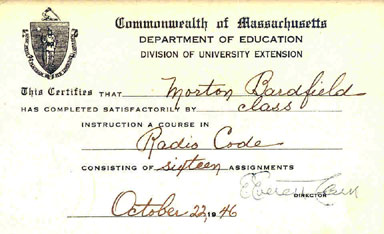
After School. During my last two years of high school, I had after-school jobs ranging from driving a small egg truck to more desirable jobs that were electronic oriented -such as working at the Radio Shack, wiring of hi-fi amplifiers and Transvision TV kits, and working in a Dorchester radio repair shop. The gentlemen who owned the repair shop worked days as an engineer for a local company called Sub Signal. I learned that this company was a World-War II contractor, later taken over by Raytheon's Sonar group.
School Assembly-Committee. After the war, educational films became part of our High School's curriculum, and I enjoyed my 1947 senior year in charge of the office intercom, and the auditorium's projection booth. I was pleased to be given the keys to the projection booth -and even the school elevator, and being the only projectionist, I received permission to cut many of my senior classes in order to show the films!
High School Graduation. In spite of also skipping some of the final exams -and being short of credit points, I was still able to graduate on schedule from Roxbury Memorial High School in 1947 through the kind intervention of Mr. Masterson. He was my school headmaster who called me to his office on graduation day to thank me for all my help that year, while he also “re-adjusted” my report card that had been sitting on his desk!
After graduating high school in 1947, I was ready to enroll in the evening Electrical Engineering course at Northeastern University. I was a bit intimidated because my initial class consisted of much older guys, and I didn't realize they were all veterans attending under the G I Bill. Finally, when I opened the pages of the college text books on E.E., I quickly changed my mind about attending. After seeing an ad in the local paper, I decided to enroll in a more practical full-time school, the Saunders Radio & Electronics School in Newton, Mass.
W1-Quick Hair Cut. I was 16 years old, and with my new Hallicrafters receiver, I listened to W1AW code practice, and passed my FCC exam at the U.S. Customhouse in Boston, receiving my first call, W1QHC. I got the courage to meet my first radio contact, Joe W1KSA -who owned a barber shop near my house in Dorchester. Now that I was licensed, I was ready for an occasional visit to his shop for a quick chat about ham radio.
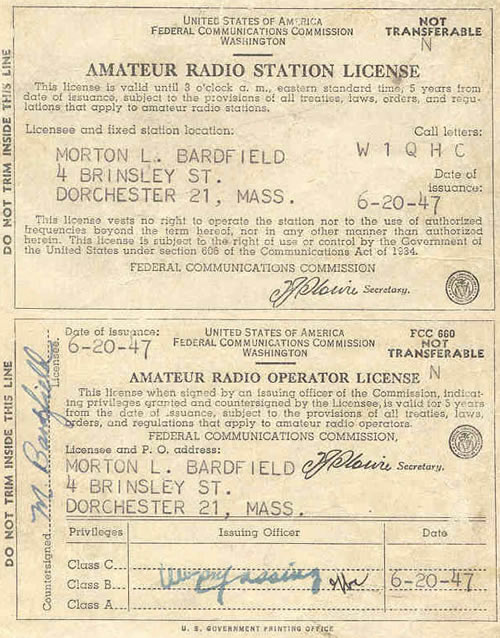
After seeing some of the post war QST ads in 1947, I bought a Millen 90800 50-watt exciter -using an 807 tube, and I built a 600-volt power supply using a pair of those beautiful blue-glow 866's. I installed a rotatable dipole and I can remember my very first DX contact. It was on 10 meters with VO6F in Goosebay, Labrador. My father came in to my room very upset and made me shut down my rig during the QSO because I hadn't done any homework. Back then, collecting QSL cards for WAS and DXCC seemed just as important as my high school report card.
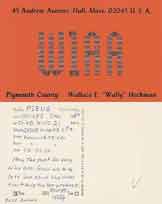
Starting in ham radio as a post war newcomer, the late 1940's and 1950's provided some memorable experiences. In the greater Boston area there were several distinguished ham operators now long gone, including code king Ted McElroy W1JYN, old-timer Irv Vermilya W1ZE, and YL operator Eunice Randall W1MPP on Cape Cod. I recall working Wally Heckman who lived near the WBZ towers in Hull, Mass. with that unforgettable call of W1AA.
Some Older Unforgettable Friends. Some other “older” hams that I knew personally were Sylvester Connolly W1MD and Art Stockellburg W1SS, and both of these gentlemen were teachers of Morse code. There was also Stu Perry W1BB whom I believe had the first DXCC on 160 meters.
QSL Card: “W1QHC de W1BB”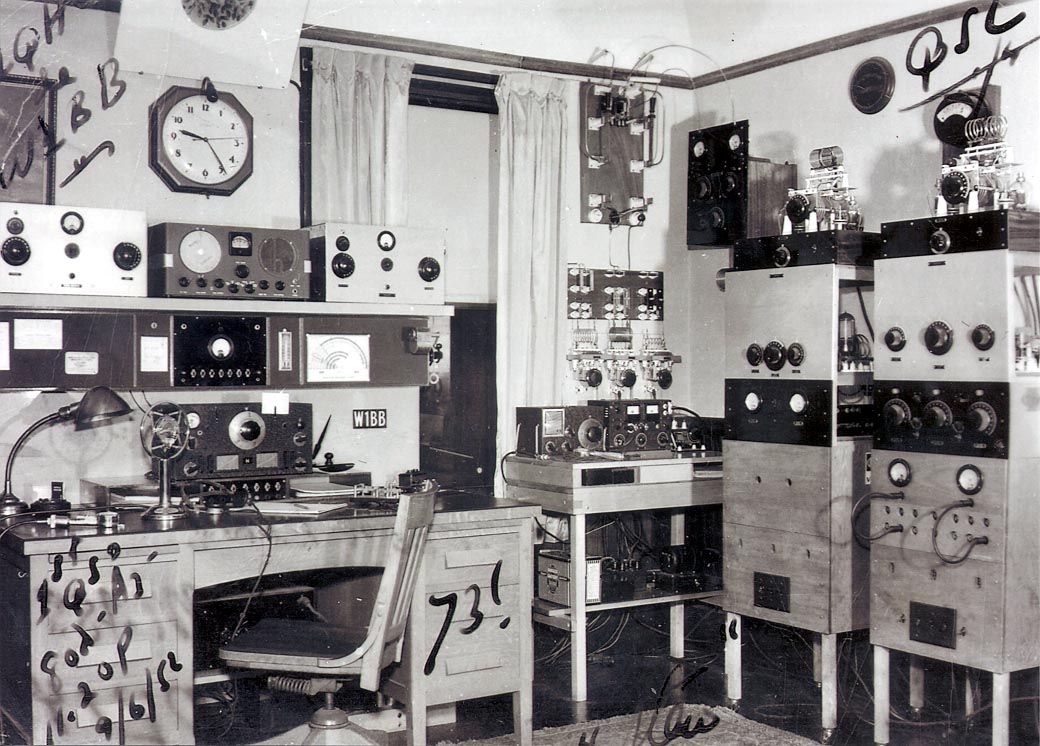
I visited Stu's ocean-side home and saw his vintage radio shack and lengthy 160-meter antenna array that ran along the Atlantic shore line in Winthrop, Mass.
There was also Norm Young W1HX, a good friend who I worked with at WEEI, -the CBS radio station in Boston, -and Mel Dunbrack W1BHD who had worked for National Radio, and was very active on ten meters.
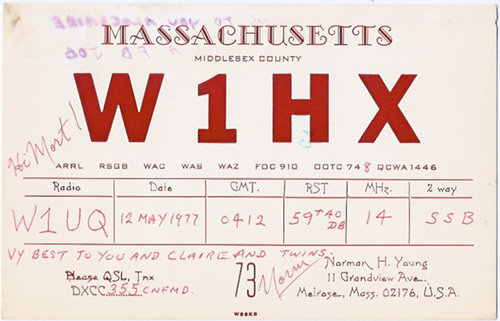
Nearby Hams. Bob Ruplenas W1DDO was a friend of Ted McElroy when they both lived in Dorchester. Bob was an engineer for General Radio and he spent much of his time on ten meters, and always helped us with any technical problems. Jerry Wyner, W1PST was a South Brookline MA businessman and town official and DX'er Charlie Mellon W1FH in West Roxbury, owned a package store in the South End of Boston. As of 2003, I have been in touch with at least two of Boston's old timers; Bob, W1DDO was still active, and Charlie W1FH, whose heart surgery kept him inactive for years.
W1FH. Having talked to several hundred countries, Charlie held the first DXCC Number 1 award after WW-II and I'm sure he was one of the hams who had worked Reg Fox in Tibet. Charlie was my DX idol in the 50's, and his operating habit was to spend 99% of his time listening, working few locals and never calling CQ! However, it seemed he was always the first to find and work the rare DX before the pile-up started! In the 70's, I visited Charlie Mellon's DX station in the West Roxbury section of Boston. Charlie had a quite ordinary station with about 600 watts and a 3-element beam, and I learned that what counted for his DXCC was actually less talking and lots of listening.
Charlie maintained a constant radio sked for about 20 years with a very close multi-lingual English ham friend that he had never met in person, -Norman Jolly G3FNJ in London, who is now a silent key. When my wife Claire and I were in London, we had a very enjoyable visit with Norman Jolly, who was the chief British military intelligence officer assigned to Greece during the war. Sadly, Charlie became a "silent key" in January 2006 at the age of 91.
Camp Edwards Radio Station. As a private in the National Guard in the late forties, I became friends with a Sergeant who worked as an announcer at the WRUL short wave studios located at 133 Commonwealth Avenue, which was only a few miles down from the huge Commonwealth Armory. The Sergeant arranged for me to volunteer at the studios, and by operating the audio equipment I was able to squeeze my way into a new (low-paying) position as their first control-room “technician”.
Studios. Short-wave station WRUL had started before World War II by the non-profit “World Wide Broadcasting Foundation” and was a privately owned short-wave stations.

The Boston studios were in a brownstone mansion at 133 Commonwealth Avenue, and there was a New York City office at 1 East 57th Street. During World War II, WRUL was requisitioned and leased to the State Department as a VOA broadcast facility.
The station was owned by Walter S. Lemmon, a former IBM president who helped develop radio teletype systems in the early thirties. He was a prominent Christian Scientist who lived in Old Greenwich, Connecticut and was a friend of Erwin Canham, the editor of the Christian Science Monitor which is still a highly regarded international newspaper.
Programs. I was told by Station Manager Ralph Wyman that the call letters stood for World Radio University, and that during the war the transmitter site which was near the Atlantic shoreline, had been guarded by soldiers.
At WRUL, we broadcast a daily news program by Erwin Canham. The station was closely associated with the Christian Science Church and the scripture teachings of Mary Baker Eddy. Another program we broadcast was produced by the Lutheran Layman's League. Our programming was either live, Scotch paper tape-recordings, and the general use of 12 and 16-inch 33-rpm acetate “platters”.
Call-letters. In 1948 the FCC decided that each transmitter would need separate call letters, so WRUA, WRUS, WRUW, WRUX, etc. were added. I believe that at about the same time, WLW -the Crosley Corp. in Cincinnati also had to add the calls of WLWO, WLWK, WLWR and WLWS.
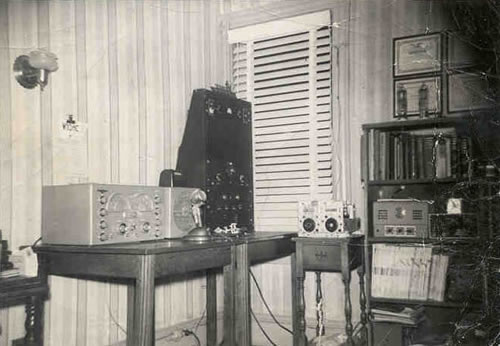 |
Transmitter Site. The WRUL short-wave transmitters were at Hatherly Beach in Scituate, located about 20 miles down the coast from Boston. On my visit to the transmitter building, I learned that Chief Engineer Lou MacDonald had designed and built several of the hi-powered transmitters, and the professional looking studio console that we operated in Boston was also built by McDonald and his transmitter crew.
To switch antenna arrays in Scituate, a long wooden pole was used to unhook and shift the overhead open-wire ladder lines. I remember waiting for the scheduled time to see the engineer shut down a huge transmitter and switch to another wire V-beam or Rhombic antenna that beamed to a different area of the world, and I also remember the trick of lighting up a fluorescent tube from the 50 Kw of RF power at the overhead feedlines!
Joining the Union. The WRUL “combo” announcer staff consisted of a few studio people who operated the microphones and audio console in the Boston, and the transmitter engineers at the Scituate site, who were all members of IBEW Local 1228. When the transmitter crew learned that I had obtained a 1st class-radiotelephone license, I was invited to join their union -as they wanted to enroll me as their first “studio engineer”. I was 19 years old and delighted to be called an engineer!
The union membership turned out to be a good opportunity, as it led me to other broadcast jobs in Boston. This included the CBS radio outlet WEEI where I first met Norm Young W1HX, and then at Westinghouse WBZ-AM and WBZ-TV in 1951 where there were about a dozen radio hams employed. Several years later I became Chief Engineer at AM station WMEX in Boston, where I was able to sit harmoniously on the management side of the bargaining table.
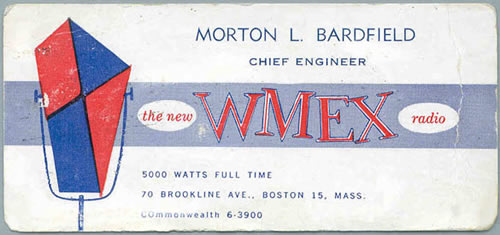
We QSL 100 percent. One of the duties at WMEX was performing a maintenance test at the Quincy, Mass. transmitter every Sunday night -on 1510 Kc. The early morning hours could be quite boring so I often took the opportunity to keep the 5 Kw transmitter fired up around 2 AM and play some country music -while announcing our station call and address.
This would inevitably result in SWL cards and reception reports from Southern states and throughout the U.S. requesting our station QSL cards. Mailing out the cards was the closest thing to playing ham radio on-the job!
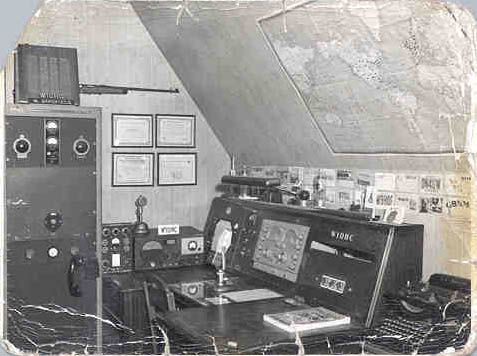 |
Nightly World News. Lowell Thomas was a world traveling radio journalist who lived in Connecticut near Walter Lemmon, the owner of short-wave station WRUL. The Lowell Thomas news program was broadcast nationwide over CBS each evening,and we picked it up off the local CBS radio station and re-broadcast it “live” on short-wave via WRUL. My job at the WRUL studio console was to cut out the Ivory Snow commercials and insert our live promo announcement. The ending cutaway was always smoothbecause I would wait for the famous sign-off with a unique up-swinging cadence -“This is Lowell Thomas saying -so long until tomorrow”.
Reginald Fox. As a ham operator, I was intrigued by these nightly world news broadcasts because Lowell Thomas often spoke of the very sparse news received from “forbidden” Tibet, via a ham radio operator by the name of Reginald Fox. This was usually difficult because the signals had to pass over the towering Himalayas. I learned that Fox was a U.K. citizen who went to Tibet with the British Mission group in 1936 -and he operated from the “closed” country of Tibet with the amateur call AC4YN. Due to Tibet's isolation before WW-II, there were only two wireless radios that existed in the entire country.
Tibet. Lowell Thomas and his son Lowell Jr. had visited Tibet and had met with Reg Fox, and the revered Tibetan leader -the Dalai Lama. With the help of Fox's wireless station, Lowell Thomas was able to receive rare news about the Chinese communist aggression against Tibet and the Dalai Lama. In 1949 the Mao-led Chinese “People's Liberation Army” invaded and annexed Tibet. Reg Fox married a Tibetan girl and left for India, but a British radioman replacement was accused of aiding the Tibetan government and was imprisoned for five years by the Chinese communists.
First Hamfest. In 1947 I attended the first post-war ARRL New England radio convention at Boston's Mechanics Hall auditorium on Huntington Avenue. It was sponsored by the Eastern Mass. Amateur Radio Association, and I remember meeting Joe DeMambro, the owner of DeMambro Radio in Brighton, and also his store Manager Bill Dean who was handing out door prizes. (I won an Astatic D-104 microphone but it was a little too elegant for my shack!) Three years later -at the 1950 convention in the same auditorium, I was able to arrange a WRUL radio program about “ham radio” with Art Stockellburg, W1SS, as the commentator. My final visit to this old convention hall was about 5 years later at a Shriner's convention.
Reminiscing. Ironically, now standing on the same exact site as the old Mechanics Hall is our “downtown” condo in the Prudential-Belvedere Residence, where we arranged with the builder to install Ethernet and coax cables to the roof -for our UHF radio link gear. I can also look out our window at the Christian Science headquarters building, where editor Erwin Canham broadcast the WRUL international news, -back in the late forties.
Enlisting. At the same 1947 ham convention, I came across an eye-catching display of army radio equipment. I was too young for World War-II so it was nice to twist the knobs on all the olive-drab military radio gear. I have to admit, those Signal Corps radios looked a lot more exciting than my Millen 50-watt exciter. I listened to the friendly radio ham in a Captain's uniform, and I learned that along with the benefits, there was also an FCC call of W1RJG assigned to the unit's ham station, -so I decided to sign up as a“26th Yankee Division” radio operator -in his field artillery unit!
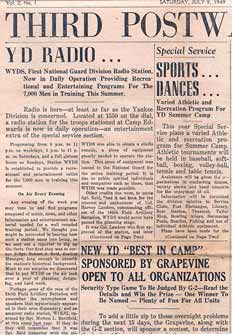
I found no ham station equipment whatsoever -and no radios, and my weekly operating experience consisted of several months of marching around evenings in the Commonwealth Avenue Armory. I wasn't very happy about this radio-ham captain who convinced me to enlist, and I certainly never dreamt that some day I would out-rank him!
Fortunately, I had learned to march from my public high-school military drill days, (we had a choice of drill or gym), -so at least I was rewarded with a promotion to Private First Class -but I still had to wait patiently for the annual summer encampment to see my first military radio. I was 17 when I joined, and quickly learned how to follow orders and continue to train... but I also began to gradually develop a respect for the military.
I had been a public school student during World War-II when there were 12 million Americans in the service, and patriotism was the normal way of life. The war had recently ended and I felt pride in wearing the uniform and being a “weekend warrior” in the new post-war National Guard.
Wired Wireless. Before starting my 1949 summer training at Camp Edwards on Cape Cod, the Sergeant (who considered himself a radio personality) obtained permission to set up a “special services” AM radio station for two weeks, to broadcast music andnews to the troops. (I had informed him that no license was required for a wired-wireless system). Our National Guard crew included some volunteer announcers, and of course I had the title of Chief-Engineer Sergeant. I had read about this no-license mode in Radio News magazine, it had seemed exciting, -to send a signal many miles down the power lines.
We borrowed a pre-war Raytheon desk-top 100-watt output broadcast transmitter, which was a real boat-anchor because it was about three feet wide and weighed over a hundred pounds. I chose a fairly clear frequency of 1550 Kc and the call letters WYDS, and fired up the transmitter. When I capacitor-coupled the RF output of the transmitter into the power lines, everything went haywire, and there was RF all over the barracks building. It was affecting our console meters, and burning the announcers' lips on the microphone, so I quickly backed down the r.f. power.
When I lowered the power to just a few watts, for the r.f to settle down, we could barelyreach a half-mile of coverage in this 20 square-mile army camp! I was very embarrassed over this big flop, so I had little alternative except to couple the transmitter to a long wire antenna, allowing two weeks of AM broadcasting -albeit to a small audience on Cape Cod! Of course, I had realized that the FCC could not court-martial me inside a U.S. Army camp, and my unit got some nice publicity.
Military Promotions. I had enrolled in Army extension courses and this helped me upgrade into various communication assignments. It wasn't difficult to do my best and work my way up the ranks as a non-com, and then with a lot more effort and study, I eventually received a direct commission as a 2nd Lieutenant. I was 22, and pinning on my gold bars was a great sense of accomplishment, just as rewarding as passing my first FCC exam!
Retired Reserve. After over 20 active years in the Guard, I transferred to an Army Reserve R & D unit at M.I.T. and had several extended-duty assignments at Fort Monmouth, and the Natick Quartermaster Labs in Massachusetts. After serving as a State House military aide , I retired from the reserve after almost 30 years of service, with the rank of Lt. Colonel. Looking back, I have always valued the entire military experience and especially the leadership skills that I really learned best by starting the hard way... as a private! My oldest son David is presently a U.S. Army Reservist and enjoys his training and experience in the Military Police.
Flying. During an earlier National Guard encampment at Camp Edwards in the late forties, had volunteered for all-night guard duty at the airstrip. The incentive was an exchange for an airplane ride in an Army L-19 observation plane. At age 18, the excitement of strapping on a parachute over my uniform and that first flight got me hooked on flying.
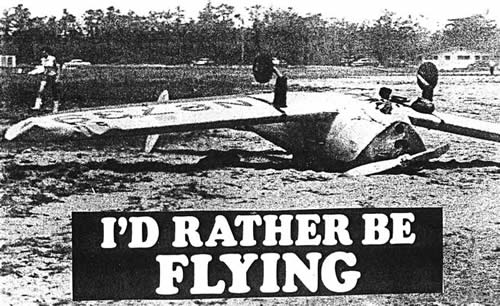
It eventually led me to further aviation activities which included the C.A.P., a commercial pilot's license, a hot-air balloon rating, -and one airplane crash!
Being a bachelor until the age of 46 meant that in addition to my interest in ham radio, I had the time and opportunity to enjoy several other enjoyable activities which included shooting, skiing, press photography, motorcycles, and power boats. I also learned the hard way that totaling my upside-down 65 hp single-engine Ercoupe was still more forgiving than totaling a 1200-cc Harley Electraglide. Luckily, I was able to walk away from both accidents with no serious injuries, but with a lot more respect for skill.
My interests and especially ham radio kept me busy, and I was one of the few guys in my group that had enough interesting activities going so that I never found the time to drink beer, didn't dance, and never had the interest to gamble, play golf, play cards or shoot pool!
I learned early on that listening to charming salesmen and new friends can easily lead to believing that everything they say is gospel! As I grew older (and smarter in business) I became less of a believer in most of the smooth sounding “experts”. I also found the odds are better when you seek information from a salesmen with gray hair.
Back in the 60's I enjoyed flying as a hobby and earned a commercial pilot's license. I quickly became friendly with an airline stewardess who was a tenant in my building. She introduced me to her friend, Frank, who was a young co-pilot with PanAm based at Logan Airport. Frank seemed like a very knowledgeable pilot -who would drop by my Beacon Street “Back Bay bachelor pad” always dressed in his neat uniform. He would typically bring along some of his attractive Boston-based airline stewardesses.
Frank was polite and likable -and along with his smooth handling of the girls, he was very knowledgeable in answering all of my eager “hanger talk” questions about airline cockpit procedures. He talked about engine rotation, V-2 speed, aborted takeoffs, and the exciting “flight deck” rules. If I remember correctly, one of the girls thought that Frank had been helped getting his job by a relative or friend who might also have been a PanAm pilot.
Cashing Checks For Friends. Before long, Frank began writing me a series of bounced checks -and apparently to many others, before he ran out of excuses and ended up in the Chelsea, MA District Court -and then left town suddenly. Unbelievably, some 35 years later I saw my old pal on national television as a wealthy security expert. I bought his new book, saw his best-selling movie, and confirmed that when I knew him in Boston, he was in fact a 17-year old impostor!
Frank, whose full name was Frank W. Abagnale Jr., after leaving Boston went off to a long career of impersonations and the eventual embezzlement of millions of dollars, and spent several years in jail in France and the Unites States. He summed up his exploits in his book by stating “My youth provided my lack of fear” ...I'm sure there are many of us older guys that can look back and relate to that statement!
Public Safety. After World War II, it seemed that most vehicles with an 8-ft whip antenna belonged to the police or fire department -or a radio ham! Many police dispatchers in the 30-50 Mhz public safety band had stories to tell of “band openings” when they conversed with other departments 1000 miles away. Before long, the large cities that didn't require extended rural coverage were all moving up to the 150-MHz band.
Motorola 2-Way. Those first police mobile radios that I saw were pre-World War-II slug-tuned receivers, made by Link Radio, and they were being replaced by transceivers made by the Galvin Mfg. company, which became Motorola. After the war, the Boston Police radio system (with the call-letters WRAS) was operating partially cross-band, with some vehicles still receiving on the 30-40 Mhz band and transmitting on the 150-MHz band.
A senior technician of the Boston Police radio shop, Bob Dillon, told me that Robert Galvin, the head of Motorola, had often visited Boston to chat with Captain Arthur Vickerson, the designer and technical head the Boston Police radio system. Vickerson had integrated the several operator positions into one large semi-circular control console that was referred to as “The Turret”.
When the department went fully VHF sometime around 1950, all the unmarked detective cars were black Chevy sedans and instead of using external antennas, Capt. Vickerson used a thin 15-inch VHF whip mounted inside the car, on the rear window shelf. I copied this idea for my new '51 black Chevy.
Mobile Operation. During the late forties, 10-meter AM was the band of choice for local mobile radio operation, and those of us with automobiles joined the Civil Defense mobile radio net. We would all drive up to the top of Belevue Hill, Parker Hill, and Corey Hill for the weekly net check-in! Some lucky members were able to get a free trunk-mounted Harvey-Wells TBS-50 transceiver and a 12-volt Leece-Neville alternator. Amateur 2-meter mobile radios soon became popular, especially after the arrival of the Gonset converters, and my favorite VHF rig was the synthesized Clegg FM-DX.
Sometime in the 1960's, there was an emergence of 2-meter “repeater phone-patching”, and I used a large AT&T touch-tone desk dialer mounted in my car for making phone calls. Of course, there were always a few Bell System hard-heads claiming that wireless interconnects were illegal.
Hand-Helds. I recall seeing a small touch-tone 2-meter hand-held phone. It was built by a local ham friend, Ron -KB1RO. He had stripped a small touch-tone pad from a Princess phone and mounted it on a small “vest-pocket size” VHF hand-held, that was made for government agencies by Bell & Howell in Waltham, Mass. Naturally, I had Ron make one for me.
This pocket size “phone-patch” was at least ten years before hand-held cell phones became available, and it was a real conversation piece! Making a phone call while walking around was something only found in a science-fiction movie. My favorite trick was phoning a date from outside her front door to say that I'd be late, -while knocking on the door. Who would realize that some twenty years later I'd become involved in the start-up of a cellular telephone system!
Tower Collapse. In August 1954, I was working as a studio technician at WBZ-TV in Boston. The station had a 650-feet self-supporting TV tower next to our two-story studio/office building. Hurricane Carol had just approached the Boston area -and the producer of the noon-time news show decided to show the intensity of the storm with a TV camera pointed at the top of the tower.
We aired live coverage of the upper portion of the tower with the large Channel-4 antenna on top, swaying back and forth in the wind. As the swaying continued, the flexing of the top of the tower was so ominous that the station manager wisely decided to evacuate employees from the second-floor offices.
Within minutes after the last person evacuated, the tower came down! Instead of that swaying top section snapping off, the tower buckled over several hundred feet lower -and much closer to the base. The entire top three-quarters of the huge 4-legged towerwent over, crushing a portion of the station's roof, and the tower ended up straddling several hundred feet across Soldiers Field Road. Luckily, when the dust settled, no one was hurt.
Some of us remained in the building to help with the mess, but I opted to leave and drive through the storm for the few miles to my Dorchester home, so I could get on the ham bands.
Emergency Traffic. Most of the downtown Boston telephone exchanges were down, but surprisingly, my home phone line in Dorchester was still working, along with our AC power. This storm was slow-moving and covered a wide area and it seemed to linger all day, before heading up the New England coast. The ham bands were very quiet, but I did a lot of listening and very little transmitting.
Nantucket Island. I kept scanning a very quiet 75-meter band and it paid off because I came across an very urgent sounding “CQ-Boston” call. It was an emergency-powered station at the Nantucket airport. There were two operators at this station and they seemed elated to learn that I had a working telephone.
One of the gentleman who was apparently a meteorologist -said it was urgent that I contact the weather bureau office at Logan airport to relay weather readings. I was asked to stand by on the frequency and relay their updated measurements, which were being given to me about every fifteen minutes.
Weather Data. The Nantucket personnel requested me to not disconnect the phone line, but to keep it open to Logan airport's speakerphone, so it was difficult to leave my shack that day without their permission! They explained that their off-shore location was very critical because it was the first land-fall for tracking the storm that was heading Northwest into the coast. Apparently Nantucket was right in the eye of the hurricane.
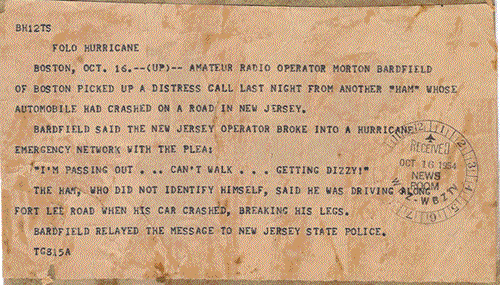
My telephone line was getting noisy so I thought it wise to have a back-up phone line available. I took a short break to tap into our downstairs neighbor's drop line. This phone line had dial-tone, and had been very tempting as it passed at arm's length right over our back porch. I was scheduled to return to the TV station later, but as an excuse to stay on the ham bands, I told my WBZ-TV boss, Sid Stadig, that I was standing by to report for National Guard duty!
Later on, I was also able to relay a distress message that I received as a “Mayday” call from an injured New Jersey ham operator whose car had run off the highway. I worked another ham in W-2 land who made a phone call to the N.J. State Police.
Awards. Several weeks later, I received a letter and public service citations from the U.S. Weather Bureau, and also from the ARRL! About a month later, I was even more surprised to receive a certificate from the General Electric Company which was the 1954 Edison Radio Amateur Award.
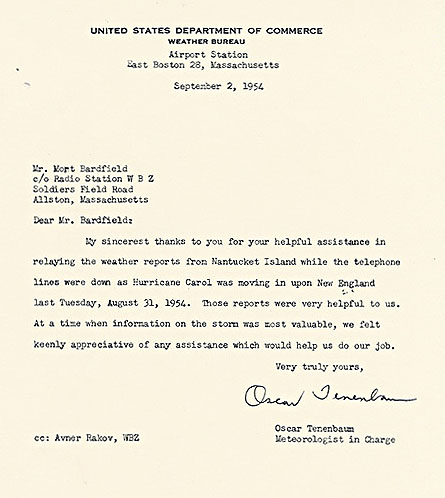
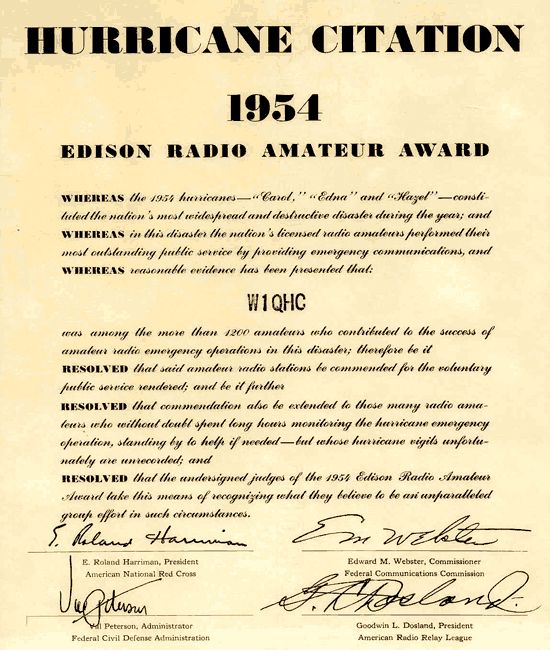
With the experience and the friends made while employed at WBZ and WBZ-TV, I developed an interest in audio and motion pictures. I left the station to join a business venture with two TV producers and served as the engineer and partner in Trans-Radio Productions, an audio-video recording studio that produced records, kinescopes, and motion pictures. We also had the exclusive contract to record and release recordings of the satirist singer "Tom Lehrer".
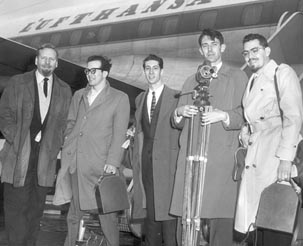 Transradio Crew, waiting to board the Lufthansa Super Constellation. L to R: Skitch Henderson (NBC Composer), Morton Bardfield, Lou Lindauer, “Donald” (WBZ Cameraman), Dick Schultz (WBZ Producer). Transradio Crew, waiting to board the Lufthansa Super Constellation. L to R: Skitch Henderson (NBC Composer), Morton Bardfield, Lou Lindauer, “Donald” (WBZ Cameraman), Dick Schultz (WBZ Producer). |
Trip to Europe. Their was an interesting assignment by our studio in 1956 when we produced a travelogue film for use by Lufthansa Airline and NBC, that was called “Castle in the Clouds”. The commentator for the film was Skitch Henderson, the music conductor for the N.Y.C. Pops and NBC. We all flew to Germany in a Lockheed 1011 “Super Connie” with the incredible wing-tip tanks that bounced up and down in rough weather, and in those days we needed a refueling stop in Gander, Newfoundland.
This documentary on Germany's musical heritage won an award at a Montreal Film Festival. and it was the first post-war travelogue, as the airline wanted to attract North American tourists back to Germany. Almost ten years had elapsed since the war, but when one looked down from the higher buildings, there was still lots of bomb damage visible -especially in industrial cities such as Mannheim, Munich and Stuttgart. On the streets there was still a few brazen “Americans Go Home” signs.
My First Purchase. By the mid-fifties, I had good jobs in broadcasting, was single, and living at home, which made it easier for me to save. I had been warned that real estate prices were too high, but I decided to invest in a 3-family brick apartment house in the Back Bay section of Boston. It had a first and a second mortgage, and it only required a two thousand dollar down payment!
I enjoyed making improvement to the buildings, probably because my first hobby at age 12 was carpentry and woodworking. I think the mechanical ability that most radio hams have can be very useful in the building and contracting trades. As the years passed, it became financially rewarding and I became more and more involved in real estate acquisitions and the remodeling and the building of income properties.
In November of 1969 an attorney friend that I had known from Dorchester was elected Sheriff of Suffolk County -which included the city of Boston -and also the operation of the largest jail in New England. The Sheriff wanted to up-grade the department and knew of my background in telecommunications, so when he took office in January 1969, I was appointed as a Deputy head of technical services for the department.
Training. One of my first projects at the Charles Street jail was the installation of a video security system, where I met the contractor who had been an ex-radio ham in Italy. I got him interested in local 2-meter activity and he soon became U.S. licensed. Sergio who is KG1C was a big technical help with our ham repeaters.
The county law-enforcement role involved administration and physical security, and I found the on-going training to be both valuable and interesting. It included the use of weapons, chemical sprays and even riot-control training at the Smith & Wesson Academy in Springfield, Mass.
Vehicles. High Sheriff's are elected, and they and their deputies have wide powers, but one big limitation was our County budget which didn't allow extra vehicles. The Sheriff was half-serious when he asked me to buy a vehicle for my own use. I took his advice, and I simply bought a used vehicle with my own funds.
I visited the Department of Motor Vehicles, registered the car in the name of the County, and left with a set of official police plates! There were both advantages and disadvantages to driving an official car, and although it wasn't an impressive Crown Victoria, it certainly put an end to getting parking tickets.
Prison Walls. During past years at the historic down-town Charles Street jail, there were several escapes by prisoners from a maintenance yard, and they all took place over the same low portion of the wall. I was part of a plain-clothes team that would go out into Suffolk county and try to apprehend some of the local escapees. I also looked into ways to prevent escapes and found that in previous years the maintenance crew would simply string more barbed wire at the top. It was a no-brainer that we also had to raise the height of the brick wall -but again, there were no funds left for this improvement.
I arranged a “barter” deal with my friend George, a “brick-layer buddy” from the North End of Boston. His masonry crew built a neat 7-foot addition on the wall. Needless to say, during our tenure no prisoner ever escaped over that wall, and my friend was quite happy when he received his “pre-arranged compensation” -consisting of a large honorary deputy sheriff's badge!
An unforgettable escape that took place was a non-violent ‘inside job' by a prisoner named John Michaelson. John was a very friendly polite person, cherub looking and over-weight, with horned rim glasses, and was quite personable and knowledgeable. He had been a gambler and a bank embezzler. Because he was good with bookeeping and paperwork, and all the guards liked him, and since he comitted only a "white-collar" crime, he was assigned as a trustee to help out in the main bookeeping office of the jail. Before long he showed up with all of his official release papers, and he even arranged a large going-away office party, paying for a large party cake. Two weeks later, when the feds requested for him for trial, we discovered he had forged all his discharge papers!
Telephone Black Boxes. At a law enforcement seminar I attended, there was an FBI agent discussing telephone fraud using illegal long-distance “Black Boxes”. He had a display table of several illegal “Multi-frequency Black Boxes”. I spotted one of the units that had been built as a “hack” a few years earlier by a ham friend, Tom S. -a “brainy” MIT E.E. grad.
A few years earlier I had watched Tom test the box with a direct-dial free call to the Melbourne Australia weather bureau! Soon after, he made peace with Ma Bell and he passed his home-brew 15-digit key-pad device to a phone company security man. Tom was an early computer whiz and is now a College professor in Boston.
The Good Guys. The few New England Tel & Tel security personnel in Boston seemed to have one trait in common; they were mostly retired FBI agents! In recent years the U.S. Secret Service has also had an interest in the internet and Cyber crimes. This includes telecommunications fraud, and the agency has a working relationship with the Carnegie-Mellon institute in Pittsburgh. My son Edward, W1RES, had some experience with cellular intercept equipment and Doppler DF gear in St. Maarten, and had an interesting job interview with the Secret Service in Boston. With this experience, Ed was given security clearance to serve as a communications consultant for enforcement personnel based in the Caribbean.
Harbor Police. The County Sheriff's department included the city of Boston, three other coastal cities, and Boston harbor. When the Boston Police disbanded their harbor patrol, we outfitted a personally owned power 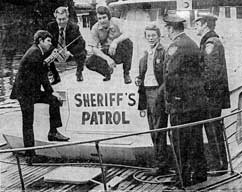 boat that was re-named the “Suffolk County,” and naturally, our ship's radio gear included a 2-meter radio. We had several guards who were ex-Navy and they were happy to come aboard for a little sea duty. With some added study and hands-on boating experience in our new Harbor Patrol, I was eventually able to secure Coast Guard Captain's license.
boat that was re-named the “Suffolk County,” and naturally, our ship's radio gear included a 2-meter radio. We had several guards who were ex-Navy and they were happy to come aboard for a little sea duty. With some added study and hands-on boating experience in our new Harbor Patrol, I was eventually able to secure Coast Guard Captain's license.
Greater Boston Police. Back on land, I was chairman of the Greater Boston Police Council radio committee, and I met some fellow officers who were radio hams, including John Pineau WA1RHN of the Boston Police, and Bob Tiffany, W1GWU, a Rockingham County N.H. Sheriff.
Police Radios. Government funding for improving communications systems had become available, and I was asked to help the State Police in upgrading their radio network. I worked as part of a small planning group in the executive office of Public Safety on Commonwealth Avenue with some of the state's finest. The group included State Police Commissioner Charlie Barry (who was the former ex-Boston Police Superintendent), State Police Colonels John Trabuco and Jack “O.D.” O'Donovan, and Captain Robert May of Brookline.
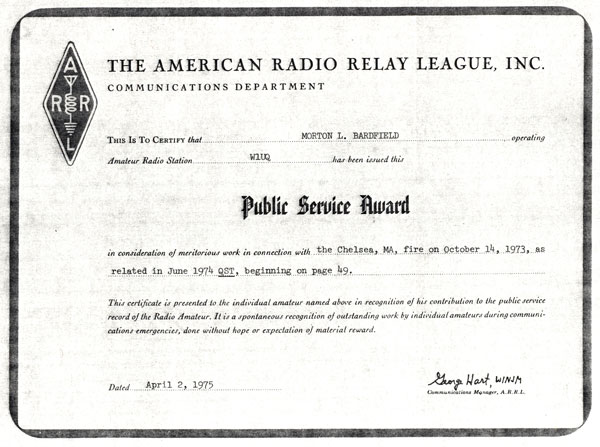
In my home town of Brookline, Mass, the police department was still operating on a 39 MHz simplex, and I was retained as the Town consultant to specify and bid out a new radio system on the 471 MHz band.
Home QTH. My brick apt. building is located on a hill overlooking the city of Boston, so it was an ideal location to license a Sheriff's auxiliary transmitter at this home QTH. Some years earlier I had formed the Brookline Amateur Radio Club and installed a 2-meter repeater. With it's good down-town coverage, the VHF repeater has been used for the last 25 years for most of Boston's marches and charitable events including the Walk for Hunger and the Boston Marathon. The repeater now has a very easy to remember call, -W1FCC!
Brookline Cell Sites. As the radio consultant, I participated in the town's cellular antenna hearings, and amateur radio came to my aid with lots of zoning information from a ham friend and zoning attorney, Fred Hopengarten K1VR. It didn't do much good however -because the rather liberal Brookline town attorney opened the meeting by publicly stating that our “over-educated” town should enact a new by-law that makes it as difficult as possible for companies to install cellular antennas. A 100% residential restriction was also enacted!
After the meeting, the “Nimby's” -(Not In My Backyard) members left the town hall victorious, and happy with the new restrictions, knowing that no one in Town would ever die of radiation sickness. If they ever read a radio manual, they also would have banned gunn diodes.
Dial 911. Sometime in the late sixties I read about a universal emergency telephone number -911, that an Illinois congressman was promoting. Although this plan was in its infancy, I was very enthused with the concept and felt that my town could be one of the first Police Departments in Massachusetts to implement it. I spent several months trying to convince my town fathers, the Police Chiefs Association, and the local Phone Company. Ironically, Governor Dukakis lived in Brookline, just a few blocks from the Police Headquarters.
911 Awareness! The president of the Mass. Chiefs of Police answered my letter by stating it would be better to just get the departments to standardize on the XXX-1212 number! I eventually paid for some large promotional ads in the local newspaper, and persuaded our local State Representative, Jack Backman, to file a bill in the State House!
Apathy. Later on, I presented a 911 paper at a Carnehan communication conference in Kentucky, but the 911 concept still ran into apathy and various Telco concerns about geographic call-routing. After four years, there were only about a hundred U.S. cities to install the 911 system, and it took many more years for it became widely accepted.
A new enhanced E-911 system that includes wireless will some day help to save even more lives because it will provide the public safety operator with the accurate physical location of each cellular caller. However, it's an added cost to the wireless carriers, so it's just as slow in forthcoming, but the good news is that it's federally mandated.
Captain Robert May. I had known Bob May through his long years of no-nonsense leadership as Chief of Detectives with the Brookline Police Department, and he had recently moved up to be the under-secretary of the Massachusetts Dept. of Public Safety. I remember that it was Captain May who countermanded the Governor and ordered that a plain-clothes officer would have to accompany Governor Michael Dukakis, when the mulish Governor wanted to ride alone on the streetcar to the State House each morning!
I recall Bob asking me to drop by his Brookline home one day to meet a Tennessee businessman, his good friend and fellow Marine by the name of Fred Smith whom he had served with in the Marine Corps during the Pacific War. The gentleman had a southern accent and was wearing a sharp-looking pair of cowboy boots! We talked about security and 2-way communications for his fledgeling air-cargo company, for whom Bob May would be serving as the U.S. Chief of Security.
After the meeting, I gave Bob my personal thoughts about the high costs of owning and operating jet airplanes, competing against Air Parcel Post, and the poor odds of profitabilty. I shouldn't have spoken so quickly that day, because it was certainly a very wrong prediction about Fred Smith's new company which was named Federal Express.
Captain May passed away in April 2005 with full military and law enforcement honors. The procession of vehicles was well over one mile long, and the State Police and Brookline Police officers were stationed at every single intersection on the entire route.
Club Memberships. As a director of the Old-Old-Timers Club for the first call area, I look out for new members (licensed over 40 years). Recently, after a contact with Will Dennis W1WA in New Hampshire, I became a member of the International Police Association Radio Club. The OOTC has been around since 1947, and the IPARC was formed back in 1966.
I enjoyed dating, and I appreciated some of the advantages of being single for many years. At age 45 I met a pretty British teacher living in my apartment building who had been studying at MIT. Claire had taught science and physics in England and was now with a local Brookline public school, and she soon became a steady girlfriend.
Bermuda. In 1976 we went on our Bermuda honeymoon along with an attorney friend, K1UN and his XYL, -and an Atlas-210. We were invited to use the VP9 Club Station and became friends with Tom and Edna Hall, VP9IB and VP9IX, and also Ed Kelly VP9GE, who later stayed with us in Boston. Ed Kelly's son Tracy was a college student in Boston, and we arranged a summer job on the evening shift at the Charles Street Jail, where he could get in some late-night reading time! Tracy Kelly is now a court officer in Bermuda.
Twin Harmonics. About nine months later, a “diaper damper” applied to Claire's ham activities when we had twin “harmonics” named David and Melissa.
The birth announcement for our twins...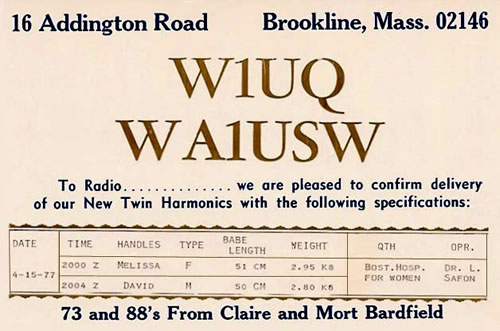
She quickly mastered radio theory and the code, and passed the FCC Extra-Class exam, and in short time obtained the vanity call of K1YL. By that time my YL had become my XYL, and was also able to follow up with her British ham license and the call of G4EZH.
 5Z4XL. Our next trip was a bit more exciting than Bermuda, as we operated in Kenya, along with our friends Bill Poellmitz K1MM and the late Jim Dionne K1MEM. We went on Safari in the Albermarle Game Reserve with my compact Atlas-210 transceiver. Back in Nairobi, we also operated from the ham shack of the late E. Robbie Robson 5Z4ERR, who held the Number-1 DXCC award on the African continent. Robson's first call was VQ4ERR, and this was probably when Kenya was called British East Africa. The door to Robbie's back yard radio shack had been covered with steel bars, porcelain insulators, and high voltage wires -to frighten off intruders during the Mau Mau rebellion.
5Z4XL. Our next trip was a bit more exciting than Bermuda, as we operated in Kenya, along with our friends Bill Poellmitz K1MM and the late Jim Dionne K1MEM. We went on Safari in the Albermarle Game Reserve with my compact Atlas-210 transceiver. Back in Nairobi, we also operated from the ham shack of the late E. Robbie Robson 5Z4ERR, who held the Number-1 DXCC award on the African continent. Robson's first call was VQ4ERR, and this was probably when Kenya was called British East Africa. The door to Robbie's back yard radio shack had been covered with steel bars, porcelain insulators, and high voltage wires -to frighten off intruders during the Mau Mau rebellion.
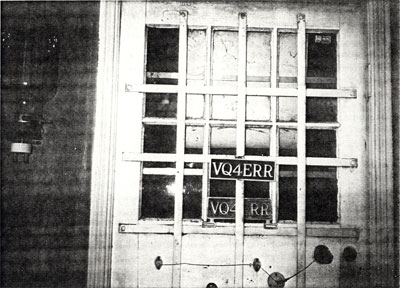
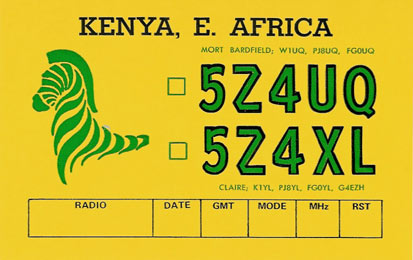
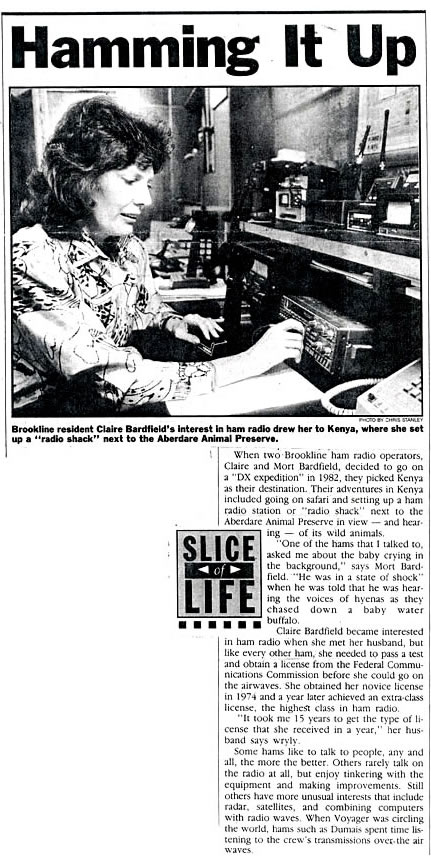
Back in the mid 70's, a friend in the charter travel business had pointed me to Dutch St. Maarten. On our trip there, Claire and I took along some ham gear which included an Atlas 210 transceiver and a Butternut vertical. The travel agency had reserved a villa at the Mullet Bay Resort on the North side with a clear path to the U.S. Not surprisingly, we received a rear villa in the worst location for an antenna -and partly on the golf course! My first thought was to wait for dark and hang the antenna from a nearby palm tree.
Great Encounter. The desk clerk wouldn't change our rooms, so I decided that my next try was a meeting with the hotel manager, Mr. Ferrier. His response was something to the effect of “well, most folks come down here to sit in the sun or bang their golf balls around, but no problem, if you folks want to stay and play radio, then hang your antennas wherever you need to!"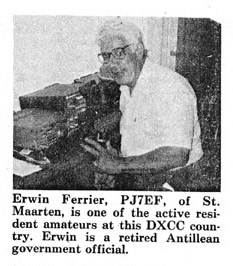 Not only was this good news, but he also sent over a maintenance man with a stepladder.
Not only was this good news, but he also sent over a maintenance man with a stepladder.
Later that evening, we got another pleasant surprise when a friendly gray-haired Dutchman knocked on our door and introduced himself as Erwin, PJ7EF, a local ham who wanted to visit our station, and even offered to be our island host. We asked how he discovered us, and he said it was easy, the resort manager Mike Ferrier was his son!
Making New Friends. Mike, and his dad Erwin (who was a retired Government radio operator) invited us to come back again soon, and insisted that staying only one week on Sint Maarten was too short a visit to appreciate their Island, -and we wisely took their advice! For the past 28 years we have been friends with the Ferrier family. Mike is a fellow pilot who keeps a twin-engine Cessna at Juliana Airport . He is a local businessman and a political official. Sadly, Erwin became a “silent key” in June of 2002 at the age of 80.
When our three children were old enough to travel, I became more familiar with the island infrastructure and became involved in some residential and commercial real estate development. This worked out well due to my stateside experience in real estate. The island investments helped us establish residency on the Island , and Claire and I then became eligible to take the government radio exams (at a modest 12-wpm). We soon became PJ8UQ and PJ8YL, although these calls have since changed to the new PJ7 resident prefix.
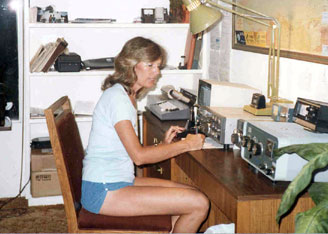
Claire, PJ7YL in St. Maarten
It's hard to ignore the other country that occupies the north side of Dutch St. Maarten, so we obtained our French residency papers in 1987. At the time, the only active station belonged to Alain Rochemont, who was manager of the French government owned electricity system. In short time we became good friends with Alain and his family. With his help, Claire and I applied to take the French ham radio exams. We were informed that in due time a radio inspector would arrive from Guadeloupe for a scheduled exam because it required a physical inspection of our proposed ham station! We would need a ham shack on the French side at that time, and since we knew the family of retired Senator Edward Brooke from Massachusetts, we arranged to set up our station by “borrowing” his large home in French Saint Martin.
The visiting government radio inspector from Guadeloupe only spoke French, so Claire did the talking and he seemed pleased that we both held FCC extra-class licenses. He skipped the expected technical questions and only tested us in copying code off the air, and we soon received our FS5YL and FS5UQ licenses, which are issued from Paris.
Reg Tibbets. When I was installing an antenna on the roof of the Brooke's estate house, I found the base of a vertical antenna that had been left by the original owner, a California engineer and radio amateur who had built this large estate on the French side of the island and sold it to Senator and Mrs. Brooke.
This builder was Reginald Tibbets, FS7RT, who in 1956 was the first resident radio amateur to operate on the Island. Reg, who was also PJ2MC on the Dutch side, sent out QSL cards that were each hand colored by his wife Louise. He would also send out commemorative French stamps to collectors, although mail service out of the island was by sea and very unreliable in the fifties.
Still missing a QSL Card?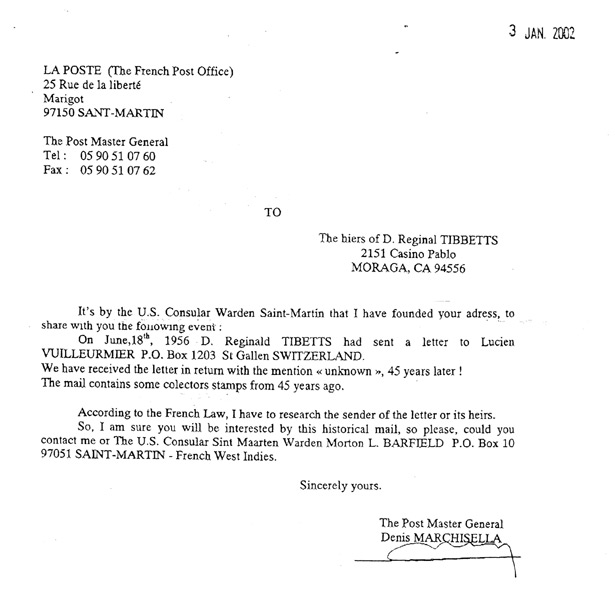
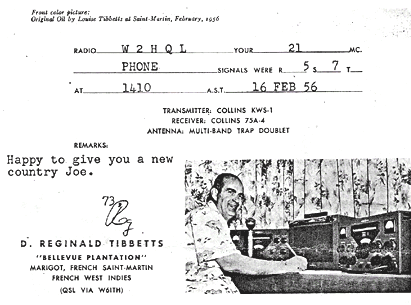
Clarence Seid, W2KW, told me that Tibbets had mailed out over 3000 of these colorful cards. Speaking of Clarence, who was born in 1908, he must be one of the oldest active radio hams, and at age 95 he say's that he's still not retired as a lawyer!
The final Tibbets' estate overlooked Friars Bay and in 1958 even had its own PBX telephone system. I talked to Reg at his home station W6ITH in Moraga , California , and he reminisced about his home, and wrote to me about French Saint Martin in the fifties. I believe he was an executive with United Press radio. Tibbets, who passed away several years ago, was quite innovative and resourceful, and is still well remembered by the older residents on French St. Martin.
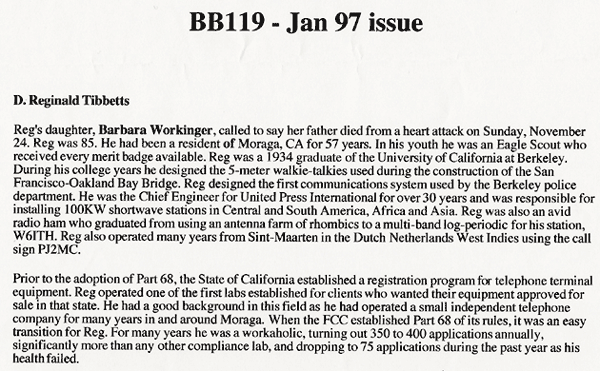
Pic Paradis. My sons Dave (N1DDD) and Ed (W1RES) helped me construct a four-room transmitter building and a cell-site tower on Pic Paradis, the island's highest point, at about 1400 ft ASL. We all couldn't resist using one of the air-conditioned rooms for a ham shack, and even installed a bathroom. In 2001 our first guest was Joe Arcure W3HNK who has been our Dutch & French QSL manager for almost 30 years.
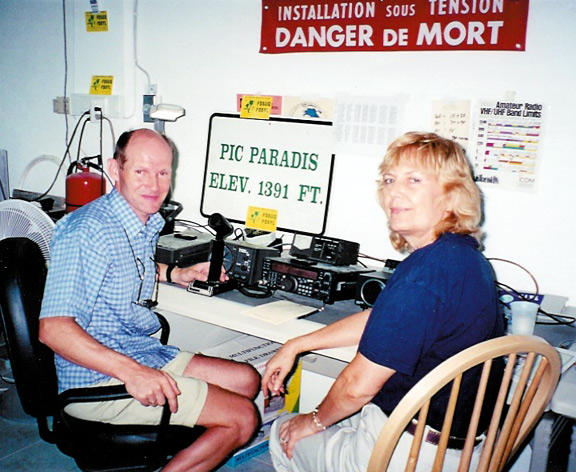
In the summer of 2000 in St. Maarten, I received a surprise visit from Phillipe, FS5BD, -a newly arrived French gendarme who was a radio technician. (The gendarmes use a police frequency near 70 Mhz, resulting in very bulky hand-helds!) I offered Phillipe the use of some ham gear, as well as the keys to the Paradise Peak ham shack. With his help we obtained a license for a French VHF repeater, FS5ZMG, and we now have a French club call, FS5KA.
Junior Ops. Sons Dave and Ed are now involved in the commercial real estate field, and also our wireless business in St. Maarten. My daughter Melissa is W1MEL, making us a 100% ham family, but she gets the most airtime by working at a local St. Maarten radio station.
Anguilla QTH. When we want a short off-island visit to a foreign island, my brother Louis, VP2EB is a permanent resident “belonger” on the idyllic British island of Anguilla which is only five miles North of St. Martin. Lou has a beam antenna and a 40 foot tower, and my wife and I are licensed there as VP2EYL and VP2EUQ. Anguilla is very flat and has no steep hills, but makes up for it with beautiful white sandy beaches.
About twenty years ago, Louis (who is also N1LOU) opened an optical store on Anguilla and also volunteered as an optometrist at the small local hospital. He discovered there was only one ambulance on the 18-mile wide island, and no way to contact it once it left the hospital! The ambulance driver, Evanson Gumbs, told us of some of the hazardous delays due to the absence of any communications. Fortunately, the hospital was on Crocus Hill, the highest point on the island, so I rounded up a handful of 2-meter Midland and Clegg 12-volt transceivers at the Horsetraders flea market back in New Hampshire.
Making use of the simplicity of radio licensing on Anguilla, we installed a base station and antenna at the hospital, and installed VHF gear in the ambulance, the doctors' offices and home, all operating simplex on 148.175 MHz. Evans became the hospital's radio operator and installer, and became licensed as VP2EG.
About a year later, just before returning to England, the Director of the Hospital, Doctor Wilson, visited Lou to thank him for our radio system that he felt was responsible for saving several lives. Some years later, Lou sponsored a free eye surgery program on Anguilla, became president of Rotary, and received a nice surprise in 2004 when he was awarded the English MBE award.
The island of Sint Maarten/Saint Martin is half Dutch and half French so hams should change call-letters as they pass the border sign! On the Dutch side of the island we became good friends in the late seventies, with PJ7EF -and with other radio hams including Alain Rochemont FS7AR, and old-timers Vinnie Labega PJ7VL and Orlando Rumnit PJ7RO.
By forming the St. Maarten Amateur Radio Club we were allowed to license a club repeater -PJ7R on 146.76 MHz which is the same frequency used in Curacao. After 25 years of service, our local Dutch repeater is now involved in the Internet Repeater Linking project.
The Colvins. The two guest speakers attending one of our first club meetings were the late Lloyd and Iris Colvin, W6KG and W6QL (King George and Queen Lady!) We held the meeting at a Chinese Restaurant in Philipsburg, where the Colvins gave an exciting talk on their world travels.
Their application form for club membership that was submitted on December 16, 1980 indicated a figure of 109 for "Other Calls Held"!
After dinner, the restaurant owner and the waiters were waiting to close but they sat nearby to listen to the Colvin's global experiences. The waiters seemed very intent but totally confused by the ham DX talk and the exotic country stories, and they assumed that the Colvins were in the world-wide travel business!
At the end of the Colvin's stay on St. Martin, we invited them home for lunch, and the two XYL's found lots to talk about, both in the kitchen as well as our ham shack.
Amateur Radio Exams. Along with my wife and two sons, we're all Extra Class examiners and we found that there had been no new hams licensed on St. Maarten in almost ten years. Knowing this, we provided free study guides and hold VE radio exams for the island residents. Our goal is to help local Antilleans get a U.S. ticket, (with a stateside address!) and then they can follow up by taking the local Dutch government “PJ” exams.
We also provided ARRL and W5YI study material to the telecommunications bureau in Curacao, and as we had hoped, the Antillean resident radio exams are now based on the U.S. exam pool!
In 1987 our amateur radio involvement and VHF repeater on St. Maarten soon led to our Dutch and French residency on the island and permanent calls. Our new Antillean status allowed us to have a commercial involvement on the island. A visiting Motorola tech-rep friend from Boston happened to chat with me about the new “cellular” telephone services.
It seemed like a risky but interesting possibility for a small market at the time. When I asked a local news editor if he knew anything about cellular systems, his reply was based on the new cells being built in the jail! Since the government wire-line telephone service was so inadequate, I decided there was no harm in applying for such a wireless license.
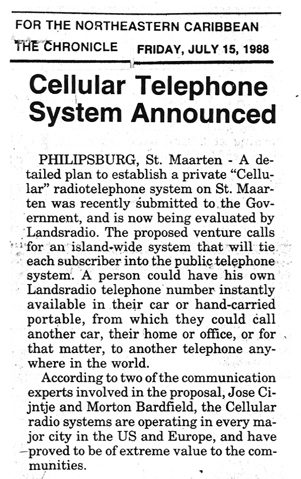
Licensing. After preparing the business plan on a friend's Macintosh 512 (he convinced me it was much better than using a typewriter), and after the typical delays and red tape, we finally obtained a cellular telephone license. Being an untested venture, there was apprehension about the success in a small market. I was concerned about the higher start-up costs, Antillean politics, tushee kissing, and other restrictions and fees and red tape that were designed to overly protect the government telephone monopoly.
Learning Cellular. By studying all available cellular technical books I quickly learned the differences between 2-way radio trunking systems, and cellular networks. It was through ham radio that I had met a retired government communications official, Jose, PJ2MI who was an active radio ham in Curacao. Jose had been the only official in Government that had a good wireless background, and he and his two sons were very helpful in steering our company through politics and the initial licensing phase.
In searching for a start-up cellular system, I found a small company in Quincy, Illinois appropriately called Cellular Radio Corp. and we leased a small 8-channel portable system. It was a typical cold December in Illinois, so the Cellular Radio Corporation designer and part-owner Andy -KD4JQT, was easily persuaded to visit St. Maarten and help install the system.
With the rapid growth of cellular, we purchased much larger systems. Some of our technicians, including my son Ed, met up with Andy Lamothe once again when they attended Andy's advanced cellular courses at the University of Wisconsin.
Joint-Venture. When the word was out that a franchise had been awarded, we were contacted by a cellular system operator in Tortola who was involved with Cable & Wireless. Their cellular system was approved in 1987 to provide phone services to boats, but the concept had quickly spread to landline users.
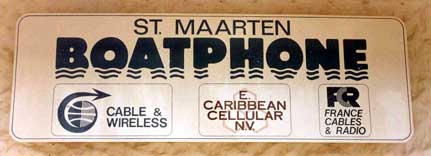
As a result, we entered into a tri-country “Caribbean Boatphone” joint-venture which included the British island of Anguilla (only 5 miles away from St. Maarten), and France Telecom -which we installed on the French half of our island, and on neighboring St. Barthelemy.
System Design. Rather than operate three independent cellular systems in three adjacent countries, it was simple to configure a system with one switch, using three international trunks and about a dozen cellsites to cover the three separate countries. Operating a system with just one master telephone switch, there would be no co-channel interference, so we operated on both the “A” and “B” systems simultaneously.
By assigning each mobile unit a “country coded” cellphone number, we could direct the incoming calls, and we could also route to the ‘correct' outgoing phone circuits.
In short time, we had to deal with bureaucratic concerns that our inter-island mobile system was acting as an international carrier, or providing least-cost routing! We found the same “monopoly mentality” about interconnecting that both the Bell System and Cable & Wireless had long enforced on their subscribers under the guise of “impairment to the quality of their network”. There was also a period of time when C & W would not even allow your privately-owned fax machine to be installed on your telephone line, as that too could "impair" their network.
Cellphone Sales. The government-owned telephone infrastructure on Dutch Sint Maarten had been historically inadequate and customer service was nil. There was always a waiting list for phone lines and repair services, and payphones were impossible to find. We initially introduced Uniden 3-watt carphones and portable bag phones, and then the large hand-held Motorola Classic “Bricks”. Needless to say, cellular usage spread rapidly as the phones got smaller, and of course the subscriber list kept growing.
The small Motorola DPC-550 flip-phone then became such a popular item that we appointed independent dealers to market them. As a carrier, we didn't need the profit from selling hardware, and we appointed a local entrepreneur who obligingly chose the name Cellular-One, registered it on the island, and became the largest independent dealer in the East Caribbean. He eventually sold his island dealership for one million dollars!
Technical Innovations. Bill, K1MM was a multi-lingual top business executive that I had met through ham radio and he served as a board member and business consultant. Also, the attorney for this overseas venture was Jordan, K1UN. With their help, it had been easy to find professional investors. Using some ham ingenuity we enjoyed inaugurating a series of “firsts” in the Caribbean that included such features as GTE Cibernet roaming, and we included free 911 calls. We convinced the nearby British islands to implement the 911 emergency number, which they simply call forwarded to their own emergency number, 999.
It also proved functional to install “smart” fixed-cellular phones that were made by the Tellular Corporation and Nortel. These wireless interfaces were placed in many homes and businesses. They enabled a regular desk phone with an RJ-11 jack to function exactly as a land-line phone, including off-hook dial tone and 90-volt ringing. As the cellular business grew, we enjoyed implementing more add-on cellular features that hams would call bells & whistles!
We established a telephone dial-in weather number, and after considering the thousands of boats in the Windward islands, we sent the continuous weather audio to our highest hill-top site and re-broadcast it over a marine NOAA weather channel. We implemented wireless payphones, extension-phone cloning, cell-enhancers, instant-billing, and cellular pre-pay. For old-times sake, I should mention that we purchased our new billing software system from a vendor in greater Boston, and the president of the company was surprised that I had knowledge of the original owners of his factory building in Melrose, Mass... it was the National Radio Company!
With the number of subscribers increasing, we built more cell sites, added employees and kept growing, in spite of competition from an envious Government telephone company. It was several years of all work and no play (and no basking in the Caribbean sun) but being in a fast growing commercial wireless business was also very challenging. In 1998 on our tenth anniversary, the cellular corporations were absorbed into a publicly traded U.S.-based corporation. As planned, this international company continues to expand it's operation to international telephone, cable TV, and especially the new digital cellular modes.
28. CLAIRE's G3YL CALL AND WW-II Radar
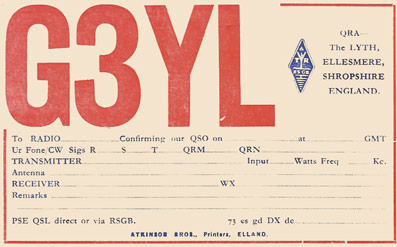
A Coveted Call: My wife Claire was born in London during WW-II and after 25 years of having a G-4 call, was fortunate in obtaining the British call of G3YL. In the U.K., old expired calls can only be issued by permission of the previous owner. This call was originally held in the thirties by an outstanding YL named Ruth Jebb McKay. We had some radio ham friends in the Ex-G Radio Club of England who knew of the eminent Jebb family, who still lived in Ellesmere. When we spoke to the Jebb family they were very pleased to "release" the call-letters to Claire, and we were told that Ruth studied science and physics at Exeter, similar to Claire's Physics degree from London University.
We saw Ruth's radio log and the QSL cards that showed activity until August 31, 1939, the day that British amateur radio was shut down -at the start of the war with Germany. It's interesting to note that Hitler had also shut down amateur radio -some ten years earlier, and as a result Germany lacked younger people with practical radio experience!
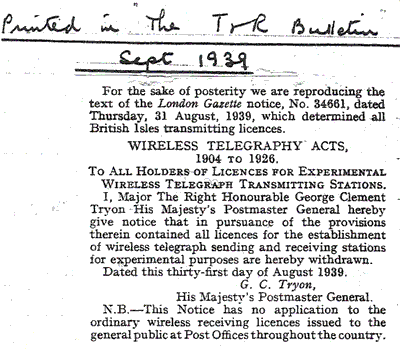
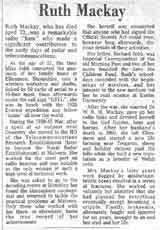
U.K. Radar. Ruth MacKay was a radio specialist who was recruited to work at the WW-II Telecommunications Research Establishment in Malvern, England, which was the U.K. 's secret radar development laboratory. Ruth helped with the development of radio beacons and radar during the war. I learned some interesting facts about the discovery of Radar, and her family sent me some photos and a list of the many British and American radio hams who worked at Malvern. Ruth lived in Ellesmere, Shropshire County, and died in 1986 at the age of 72.
M.I.T. Radar In 1940 the Malvern laboratories collaborated with the Massachusetts Institute of Technology, sending the British radar plans (and their renowned cavity-magnetron microwave tube) to Boston, to be evaluated at the MIT Radiation Labs, -and then rushed into manufacture. I read that when the MIT Radlab tested their radar during the war, their favorite down-range target was a large natural gas tank about 8 miles away on the Boston shore-line, -in my home town of Dorchester!
The Malvern and MIT laboratories operated as a joint effort in war-time secrecy, and their constant improvements to microwave technology and radar hardware resulted in radar becoming “The Invention That Changed The World” which is the title of an interesting documentary on Radar, written by Robert Buderi. When my wife Claire first arrived here from the U.K. she also was involved at MIT as a physics major.
After reading books about Radar, I learned that when the MIT Radlab closed after WW-II, three of the local MIT scientists, Denis Robinson, John Trump and Dr. Robert Van De Graaff, started the High Voltage Engineering Corporation, in Burlington Mass. This was a surprise because I had worked there in the 50's as a tech writer on their particle accelerator systems, and my friendly boss there was a radio ham, Ken Tong N1DKH.
I had operated during several strong hurricanes in the U.S. , but in September of 1995, my family was in St. Maarten -when hurricane Luis became the strongest storm in over 25 years to strike the Island . Our entire cellular system was reduced to one cell-site at our office, and only for mobile-to-mobile calls. For the first 24-hours every communication link was utterly cut off. In fact, the entire local and long distance telephone exchange and just about every wireless tower and microwave dish was out of operation due to the storm.
Category-5 winds. I found that our commercial fiberglass omnipole with a wind rating of about 140 MPH had snapped in two, along with many utility poles. I estimated that the “cyclonic winds” inside the hurricane produced gusts of at least 170 MPH! My teenage twins, David and Melissa were both rescue divers, and they had been standing by with their scuba gear at the local Sea Rescue Headquarters.
One awkward precaution that failed was in the vicinity of my home near Dawn Beach. With the hurricane approaching, the building developer had lowered the water level in the large hill-top water tank, because it was next to homes that would be flooded if the tank split. The huge unweighted tank was last seen airborne like a balloon, blowing out to sea, and was never seen again!
Yacht Damage. Most boats on the island, whether afloat or onshore, were tossed about and were seriously damaged. There were a few stubborn yachtsmen in the large Simpson Bay lagoon who preferred to ride out the storm, and there were fatalities on at least one sailboat that sank in the Lagoon. The boats that had been tied up at some of the yacht clubs turned the docks into a white fiberglass junk yard.
I saw only a few undamaged catamarans after the storm, whose owners had hauled them ashore and wisely flooded the hulls with water.
All Systems Down. Immediately after the hurricane passed, there was an eerie radio silence from the broadcast band up to the UHF band. The only radio signals heard were on the VHF marine band from a few boats on channel 16. The airport was closed for the next two days, and scheduled flights were canceled for the week. In Washington, the U.S. State Department was being swamped with inquiries on the welfare of individual American tourists stranded on the Island.
U.S. State Dept. Philip M. Jones was the American Consul General of The US Embassy in Barbados and had appointed me as a volunteer U.S. Warden for the Island. I was advised that a consular radio officer in Curacao would be using the State Department transceiver to monitor the 20-meter hurricane net. Immediately after the hurricane passed, we were able to establish the first off-island communications, thanks to amateur radio!
Health & Welfare. The State Department needed to respond to the many relatives' requests concerning the welfare of Americans. An important task during the next 48 hours was to obtain some volunteers from the local American Medical University ("AUC") and set up a control point in my office to handle the inquiries about tourists, and trying to locate them.
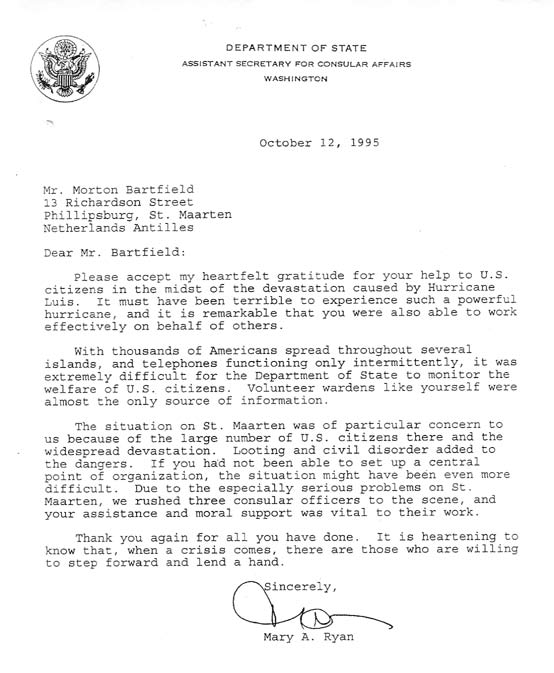
It was important to first locate elderly tourists and also those with small children. We then had to ensure that arrangements were made for all American tourists to return to the U.S., hopefully on their original air carriers.
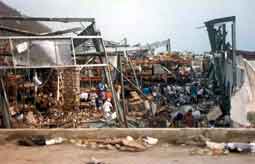
I learned that most of the State Department inquiries about the stranded Americans tourists originated from Congressmen who passed on requests from their districts, so we gave priority to these official requests, and with difficulty, we were able to reach all of the hotels on the Island. A few weeks later, I received a letter of commendation from the Consular Affairs office in Washington.
U.S. Navy. After the hurricane passed, I met with the island's Lieutenant Governor and a U.S. Navy Commander who arrived on the Island by helicopter. It was gratifying to hear from the Commander that if needed, the U.S. Navy would quickly provide the Island with water, electricity, a field hospital, and would also arrange for the evacuation of American citizens with navy vessels. Within a few tense days however, the recovery process had commenced with Dutch equipment and manpower flown in from Curacao and Holland.
The World's Best. Back in the seventies, I had been appointed a Governor's military aide in Massachusetts, and I had the opportunity of visiting the diesel-powered aircraft carrier John F. Kennedy when it was in Boston. In St. Maarten, I'm a member of the U.S. Navy League that hosts the military ships that visit St. Maarten. As a result, we had another in-depth private tour of the newer nuclear-powered carriers, the USS Theodore Roosevelt and the John C. Stennis, and it was unforgettable to visit the elaborate combat information centers.
“Where Are The Carriers” There are many vessels that make up a single carrier battle group and the Navy has about a dozen carrier groups spread out in various locations in the world. It was very impressive to learn about the strength and mobility of the U.S. armed forces that are constantly standing by.
I hope that my fellow members in the QCWA and the Old-Old Timers Club will find a bit of nostalgia in my story. Having been a fairly active ham since the late forties. I hope there are many readers of this story that also have fond radio memories during those patriotic years when we tuned in to Bob Hope and Kate Smith, and those extraordinary years of ham radio growth that began after World War II.
I also hope that ham operators and short wave hobbyists can make many new friends, and find many new opportunities and success from the hobby of ham radio, just as I did!
-73
Mort Bardfield, W1UQ/PJ7UQ
New England Director, OOTC